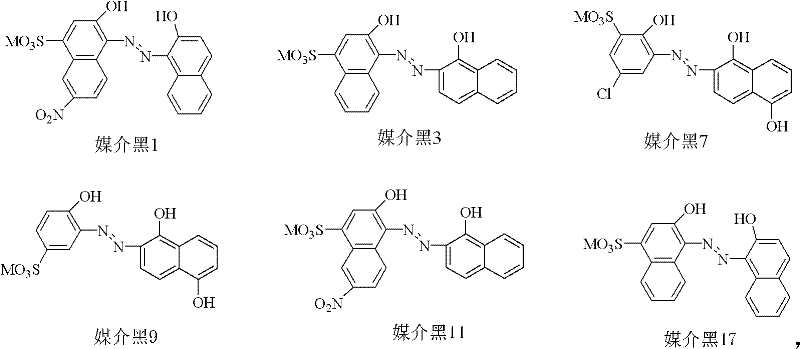Chrome complex dye as well as preparation method and applications thereof
A technology of chromium complexation and dyes, which is applied in dyeing methods, azo dyes, organic dyes, etc., and can solve the problems of poor weather fastness of inkjet inks, etc.
- Summary
- Abstract
- Description
- Claims
- Application Information
AI Technical Summary
Problems solved by technology
Method used
Image
Examples
preparation example Construction
[0059] The preparation method of the chromium complex dye of the present invention is as follows.
[0060] Under stirring, the mordant black dye and the hexavalent chromium compound or the mixture of the hexavalent chromium compound and the trivalent chromium compound used as an oxidation complexing reagent are added to the reaction vessel in a ratio of 1: (0.5-2), and Water was added as solvent. Raise the temperature in the reaction vessel to 60-150°C to oxidize the dye and the hexavalent chromium compound, and at the same time complex the dye with the reduced trivalent chromium. During the reaction, the pH value of the system is kept at 1-6, and the reaction time is 0.5-8 hours.
[0061] The molar ratio of dye:oxidative complexing agent is preferably 1:(0.8-1.5). The reaction temperature is preferably 60-120°C, more preferably 70-110°C, and still more preferably 80-102°C. The reaction time is preferably 1-8 hours, more preferably 2-6 hours, and more preferably 3-6 hours. ...
Embodiment 1
[0086]Two-step method: Add 150.0 parts of media black 7 dye to a 2L three-necked flask, add 1L of deionized water, raise the temperature to 70-80°C, slowly add 53.6 parts of sodium dichromate, heat up and boil for 6 hours, and control the pH at 6.0 , to obtain a thick black slurry, lower the temperature to 70-80°C, and slowly add 54.02 parts of tartaric acid. React for 5 hours under boiling, the pH is controlled at 3.0, the reactant becomes a solution, cooled, the pH is adjusted to 8.5-8.6, and the high-pressure reverse osmosis membrane is desalted to obtain a 1:1 chromium complex dye 7-1 of Mordant Black 7. According to HPLC-ESI-MS analysis, the product mainly contains compound dye 7-1-a and compound dye 7-1-b. The pure compounds of compound dye 7-1-a and compound dye 7-1-b were obtained by HPLC preparative separation. The molecular molar mass of compound dye 7-1-a should be 676.9 (M' is calculated as Na), electrospray mass spectrometry (API-ES) detects, and in negative mode...
Embodiment 2
[0090] 54.0 parts of tartaric acid in Example 1 were replaced with 32.0 parts of oxalic acid, and other conditions remained unchanged, to obtain 1:1 chromium complex dye dye 7-2 of media black 7. According to HPLC-ESI-MS analysis, it mainly contains compound dye 7-2-a and compound dye 7-2-b. The pure compounds of dye 7-2-a and compound dye 7-2-b were obtained by HPLC preparative separation. The molecular molar mass of compound dye 7-2-a should be 617.8 (M' is calculated as Na), electrospray mass spectrometry (API-ES) detects, and in negative mode, electrospray mass spectrometry has the base peak of mass-to-charge ratio 285.9, is The double negative ion peak (molecular mass [M-2Na] / 2) of the dye and the single negative ion peak ([M-Na]) with a mass-to-charge ratio of 594.8 all prove that the molecular molar mass M of the dye is 617.8; the compound dye 7-2-b The molecular molar mass M should be 631.8 (M' in Na), detected by electrospray mass spectrometry (API-ES), and in negati...
PUM
 Login to View More
Login to View More Abstract
Description
Claims
Application Information
 Login to View More
Login to View More - R&D
- Intellectual Property
- Life Sciences
- Materials
- Tech Scout
- Unparalleled Data Quality
- Higher Quality Content
- 60% Fewer Hallucinations
Browse by: Latest US Patents, China's latest patents, Technical Efficacy Thesaurus, Application Domain, Technology Topic, Popular Technical Reports.
© 2025 PatSnap. All rights reserved.Legal|Privacy policy|Modern Slavery Act Transparency Statement|Sitemap|About US| Contact US: help@patsnap.com



